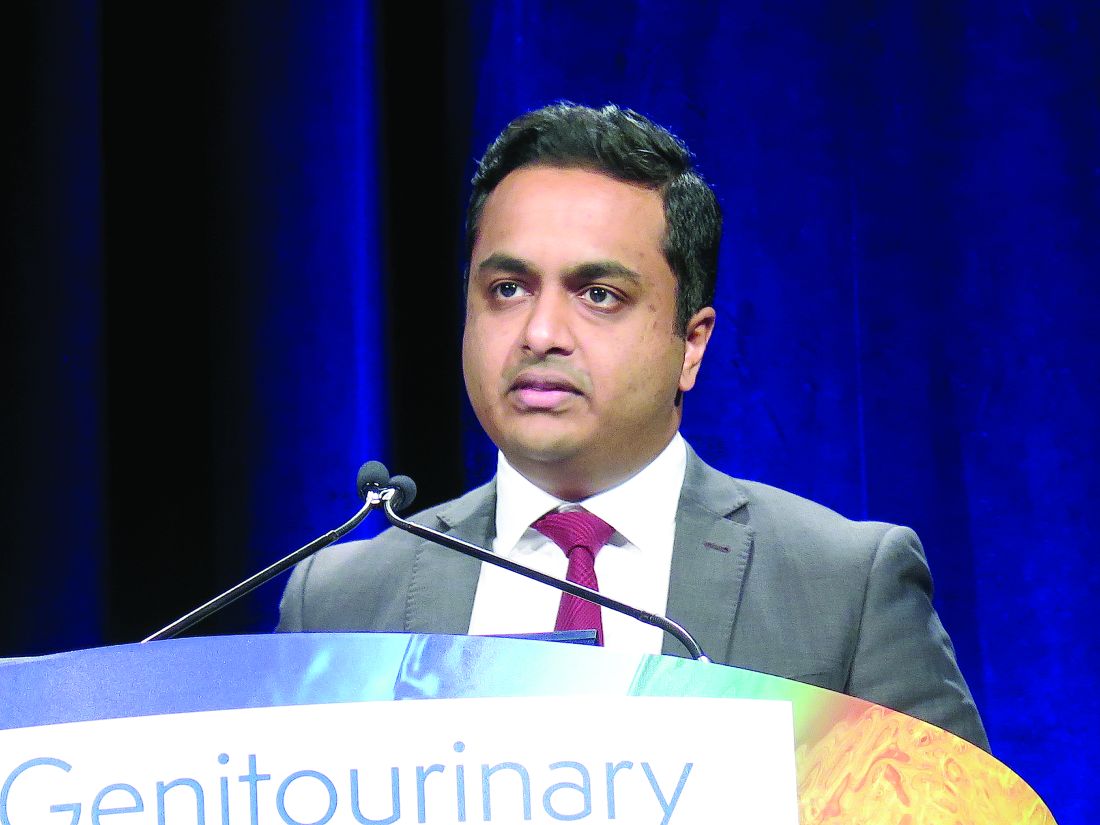User login
SAN FRANCISCO – (ADT), according to a correlative analysis of the CHAARTED trial.
Researchers found that adding docetaxel to ADT reduced the risk of death by 55% among men with luminal B subtype tumors, which corresponded to about 22 more months of life on average. In contrast, there was no significant reduction in risk of death among men with the basal subtype.
Anis Hamid, MD, of the Dana-Farber Cancer Institute in Boston, presented these results at the 2020 Genitourinary Cancers Symposium, sponsored by the American Society for Clinical Oncology, ASTRO, and the Society of Urologic Oncology.
The phase 3, randomized CHAARTED trial included 790 men with newly diagnosed, metastatic, hormone-sensitive prostate cancer. Previously reported results showed a survival benefit of adding six cycles of docetaxel to ADT (N Engl J Med. 2015;373:737-46), with long-term durability driven by benefit in men with high-volume disease (J Clin Oncol. 2018;36:1080-7).
These findings, along with those from similar chemotherapy trials, changed the treatment paradigm for metastatic hormone-sensitive disease, Dr. Hamid noted. Androgen receptor signaling inhibitors and prostate radiation have since entered this treatment space as well.
“There is a critical need to identify and better understand patients who do and do not benefit from upfront chemotherapy or potent hormonal therapy in order to guide optimal therapy selection,” Dr. Hamid said. “It is hypothesized that understanding the underlying biology will provide critical insights.”
Study details
Dr. Hamid and colleagues analyzed primary biopsies obtained at the time of metastatic diagnosis, before ADT exposure, in 160 patients treated on the CHAARTED trial. The researchers performed whole-transcriptome profiling and classification using the PAM50 gene set.
Tumors were classified as basal subtype in 52.1% of patients, as luminal B subtype in 46.1%, and as luminal A subtype in 1.8%.
Among patients given ADT alone, those with luminal B subtype tended to have poorer overall survival than those with basal subtype (hazard ratio, 1.75; P = .052). Among patients who received ADT plus docetaxel, there was no significant difference in overall survival according to subtype (HR, 0.92; P = .14).
The addition of docetaxel to ADT significantly prolonged median overall survival among men with luminal B subtype (52.1 months vs. 29.8 months; HR, 0.45; P = .007) but not among men with basal subtype (49.2 months vs. 47.1 months; HR, 0.85; P = .60). Findings were similar in an analysis restricted to patients with high-volume disease, according to Dr. Hamid.
“Luminal B tumors are associated with a poorer prognosis on ADT alone but significantly benefit from the addition of docetaxel chemotherapy upfront,” he said. “Conversely, basal subtype predicts for a lack of survival benefit with docetaxel.”
Dr. Hamid and colleagues also found that adding docetaxel significantly prolonged median time to castration-resistant prostate cancer, regardless of whether the subtype was luminal B (16.9 months vs. 8.0 months; HR, 0.43; P = .001) or basal (17.7 months vs. 6.4 months; HR, 0.51; P = .013).
Dr. Hamid acknowledged that prediction of treatment response is likely to be more complex than this research suggests and additionally influenced by as-yet-unidentified biomarkers.
“I await more biological information from CHAARTED but also independent metastatic cohorts,” he said. “I don’t think it’s likely there will be just one particular very discrete story like we have presented today. The effect size that we saw in the luminal B tumors, for example, with respect to the benefit of docetaxel, wasn’t subtle. It was big, and I am ever keen to know what is driving that.”
Clinical implications
“The landscape of treatments for metastatic hormone-sensitive prostate cancer is very complicated, and there are many, many good options and probably more than one best answer for each patient,” said invited discussant Dana E. Rathkopf, MD, of the Memorial Sloan Kettering Cancer Center in New York.
Historically, the luminal B subtype has been associated with a good response to ADT but also with a high proliferation rate and fairly poor prognosis. “So maybe the luminal B response to ADT was good, but it wasn’t good enough, given the underlying biology of this poor prognostic subtype,” Dr. Rathkopf said.
She added that the efficacy of ADT alone may have been worse than expected in the luminal B group, making the addition of docetaxel appear more favorable, as overall survival with ADT plus docetaxel was similar between these subtypes, at about 50 months.
“But still, it looks like the addition of docetaxel added benefit to these luminal B cells regardless of whether they did better or worse than was expected on the ADT,” Dr. Rathkopf said. Taken together, the findings identify luminal B subtype as a predictive biomarker of response to docetaxel in men with metastatic hormone-sensitive prostate cancer, she added.
“Can this help select patients who should and should not receive docetaxel? I think we would all agree that further validation is needed before we move this into clinical practice,” Dr. Rathkopf said. “It’s not that easy, and there are probably additional tests and additional molecular factors that we need to incorporate into these types of models.”
“As a clinician, if I see a patient tomorrow with newly diagnosed metastatic hormone-sensitive prostate cancer who is basal subtype on PAM50, I certainly wouldn’t withhold docetaxel,” Dr. Hamid said. “Withholding a proven life-prolonging therapy needs to meet a very high bar of biomarker discovery and validation independently for us to confidently translate that to the clinics.”
This research was funded by Decipher Biosciences and the National Institutes of Health. The CHAARTED trial was funded by the ECOG-ACRIN Cancer Research Group in collaboration with the National Cancer Institute.
Dr. Hamid disclosed relationships with Bayer and Merck Sharp and Dohme. Dr. Rathkopf disclosed relationships with AstraZeneca, Genentech/Roche, Janssen, Celgene, Ferring, Medivation, Millennium, Novartis, Taiho Pharmaceutical, Takeda, and TRACON Pharma.
SOURCE: Hamid A et al. GUCS 2020. Abstract 162.
SAN FRANCISCO – (ADT), according to a correlative analysis of the CHAARTED trial.
Researchers found that adding docetaxel to ADT reduced the risk of death by 55% among men with luminal B subtype tumors, which corresponded to about 22 more months of life on average. In contrast, there was no significant reduction in risk of death among men with the basal subtype.
Anis Hamid, MD, of the Dana-Farber Cancer Institute in Boston, presented these results at the 2020 Genitourinary Cancers Symposium, sponsored by the American Society for Clinical Oncology, ASTRO, and the Society of Urologic Oncology.
The phase 3, randomized CHAARTED trial included 790 men with newly diagnosed, metastatic, hormone-sensitive prostate cancer. Previously reported results showed a survival benefit of adding six cycles of docetaxel to ADT (N Engl J Med. 2015;373:737-46), with long-term durability driven by benefit in men with high-volume disease (J Clin Oncol. 2018;36:1080-7).
These findings, along with those from similar chemotherapy trials, changed the treatment paradigm for metastatic hormone-sensitive disease, Dr. Hamid noted. Androgen receptor signaling inhibitors and prostate radiation have since entered this treatment space as well.
“There is a critical need to identify and better understand patients who do and do not benefit from upfront chemotherapy or potent hormonal therapy in order to guide optimal therapy selection,” Dr. Hamid said. “It is hypothesized that understanding the underlying biology will provide critical insights.”
Study details
Dr. Hamid and colleagues analyzed primary biopsies obtained at the time of metastatic diagnosis, before ADT exposure, in 160 patients treated on the CHAARTED trial. The researchers performed whole-transcriptome profiling and classification using the PAM50 gene set.
Tumors were classified as basal subtype in 52.1% of patients, as luminal B subtype in 46.1%, and as luminal A subtype in 1.8%.
Among patients given ADT alone, those with luminal B subtype tended to have poorer overall survival than those with basal subtype (hazard ratio, 1.75; P = .052). Among patients who received ADT plus docetaxel, there was no significant difference in overall survival according to subtype (HR, 0.92; P = .14).
The addition of docetaxel to ADT significantly prolonged median overall survival among men with luminal B subtype (52.1 months vs. 29.8 months; HR, 0.45; P = .007) but not among men with basal subtype (49.2 months vs. 47.1 months; HR, 0.85; P = .60). Findings were similar in an analysis restricted to patients with high-volume disease, according to Dr. Hamid.
“Luminal B tumors are associated with a poorer prognosis on ADT alone but significantly benefit from the addition of docetaxel chemotherapy upfront,” he said. “Conversely, basal subtype predicts for a lack of survival benefit with docetaxel.”
Dr. Hamid and colleagues also found that adding docetaxel significantly prolonged median time to castration-resistant prostate cancer, regardless of whether the subtype was luminal B (16.9 months vs. 8.0 months; HR, 0.43; P = .001) or basal (17.7 months vs. 6.4 months; HR, 0.51; P = .013).
Dr. Hamid acknowledged that prediction of treatment response is likely to be more complex than this research suggests and additionally influenced by as-yet-unidentified biomarkers.
“I await more biological information from CHAARTED but also independent metastatic cohorts,” he said. “I don’t think it’s likely there will be just one particular very discrete story like we have presented today. The effect size that we saw in the luminal B tumors, for example, with respect to the benefit of docetaxel, wasn’t subtle. It was big, and I am ever keen to know what is driving that.”
Clinical implications
“The landscape of treatments for metastatic hormone-sensitive prostate cancer is very complicated, and there are many, many good options and probably more than one best answer for each patient,” said invited discussant Dana E. Rathkopf, MD, of the Memorial Sloan Kettering Cancer Center in New York.
Historically, the luminal B subtype has been associated with a good response to ADT but also with a high proliferation rate and fairly poor prognosis. “So maybe the luminal B response to ADT was good, but it wasn’t good enough, given the underlying biology of this poor prognostic subtype,” Dr. Rathkopf said.
She added that the efficacy of ADT alone may have been worse than expected in the luminal B group, making the addition of docetaxel appear more favorable, as overall survival with ADT plus docetaxel was similar between these subtypes, at about 50 months.
“But still, it looks like the addition of docetaxel added benefit to these luminal B cells regardless of whether they did better or worse than was expected on the ADT,” Dr. Rathkopf said. Taken together, the findings identify luminal B subtype as a predictive biomarker of response to docetaxel in men with metastatic hormone-sensitive prostate cancer, she added.
“Can this help select patients who should and should not receive docetaxel? I think we would all agree that further validation is needed before we move this into clinical practice,” Dr. Rathkopf said. “It’s not that easy, and there are probably additional tests and additional molecular factors that we need to incorporate into these types of models.”
“As a clinician, if I see a patient tomorrow with newly diagnosed metastatic hormone-sensitive prostate cancer who is basal subtype on PAM50, I certainly wouldn’t withhold docetaxel,” Dr. Hamid said. “Withholding a proven life-prolonging therapy needs to meet a very high bar of biomarker discovery and validation independently for us to confidently translate that to the clinics.”
This research was funded by Decipher Biosciences and the National Institutes of Health. The CHAARTED trial was funded by the ECOG-ACRIN Cancer Research Group in collaboration with the National Cancer Institute.
Dr. Hamid disclosed relationships with Bayer and Merck Sharp and Dohme. Dr. Rathkopf disclosed relationships with AstraZeneca, Genentech/Roche, Janssen, Celgene, Ferring, Medivation, Millennium, Novartis, Taiho Pharmaceutical, Takeda, and TRACON Pharma.
SOURCE: Hamid A et al. GUCS 2020. Abstract 162.
SAN FRANCISCO – (ADT), according to a correlative analysis of the CHAARTED trial.
Researchers found that adding docetaxel to ADT reduced the risk of death by 55% among men with luminal B subtype tumors, which corresponded to about 22 more months of life on average. In contrast, there was no significant reduction in risk of death among men with the basal subtype.
Anis Hamid, MD, of the Dana-Farber Cancer Institute in Boston, presented these results at the 2020 Genitourinary Cancers Symposium, sponsored by the American Society for Clinical Oncology, ASTRO, and the Society of Urologic Oncology.
The phase 3, randomized CHAARTED trial included 790 men with newly diagnosed, metastatic, hormone-sensitive prostate cancer. Previously reported results showed a survival benefit of adding six cycles of docetaxel to ADT (N Engl J Med. 2015;373:737-46), with long-term durability driven by benefit in men with high-volume disease (J Clin Oncol. 2018;36:1080-7).
These findings, along with those from similar chemotherapy trials, changed the treatment paradigm for metastatic hormone-sensitive disease, Dr. Hamid noted. Androgen receptor signaling inhibitors and prostate radiation have since entered this treatment space as well.
“There is a critical need to identify and better understand patients who do and do not benefit from upfront chemotherapy or potent hormonal therapy in order to guide optimal therapy selection,” Dr. Hamid said. “It is hypothesized that understanding the underlying biology will provide critical insights.”
Study details
Dr. Hamid and colleagues analyzed primary biopsies obtained at the time of metastatic diagnosis, before ADT exposure, in 160 patients treated on the CHAARTED trial. The researchers performed whole-transcriptome profiling and classification using the PAM50 gene set.
Tumors were classified as basal subtype in 52.1% of patients, as luminal B subtype in 46.1%, and as luminal A subtype in 1.8%.
Among patients given ADT alone, those with luminal B subtype tended to have poorer overall survival than those with basal subtype (hazard ratio, 1.75; P = .052). Among patients who received ADT plus docetaxel, there was no significant difference in overall survival according to subtype (HR, 0.92; P = .14).
The addition of docetaxel to ADT significantly prolonged median overall survival among men with luminal B subtype (52.1 months vs. 29.8 months; HR, 0.45; P = .007) but not among men with basal subtype (49.2 months vs. 47.1 months; HR, 0.85; P = .60). Findings were similar in an analysis restricted to patients with high-volume disease, according to Dr. Hamid.
“Luminal B tumors are associated with a poorer prognosis on ADT alone but significantly benefit from the addition of docetaxel chemotherapy upfront,” he said. “Conversely, basal subtype predicts for a lack of survival benefit with docetaxel.”
Dr. Hamid and colleagues also found that adding docetaxel significantly prolonged median time to castration-resistant prostate cancer, regardless of whether the subtype was luminal B (16.9 months vs. 8.0 months; HR, 0.43; P = .001) or basal (17.7 months vs. 6.4 months; HR, 0.51; P = .013).
Dr. Hamid acknowledged that prediction of treatment response is likely to be more complex than this research suggests and additionally influenced by as-yet-unidentified biomarkers.
“I await more biological information from CHAARTED but also independent metastatic cohorts,” he said. “I don’t think it’s likely there will be just one particular very discrete story like we have presented today. The effect size that we saw in the luminal B tumors, for example, with respect to the benefit of docetaxel, wasn’t subtle. It was big, and I am ever keen to know what is driving that.”
Clinical implications
“The landscape of treatments for metastatic hormone-sensitive prostate cancer is very complicated, and there are many, many good options and probably more than one best answer for each patient,” said invited discussant Dana E. Rathkopf, MD, of the Memorial Sloan Kettering Cancer Center in New York.
Historically, the luminal B subtype has been associated with a good response to ADT but also with a high proliferation rate and fairly poor prognosis. “So maybe the luminal B response to ADT was good, but it wasn’t good enough, given the underlying biology of this poor prognostic subtype,” Dr. Rathkopf said.
She added that the efficacy of ADT alone may have been worse than expected in the luminal B group, making the addition of docetaxel appear more favorable, as overall survival with ADT plus docetaxel was similar between these subtypes, at about 50 months.
“But still, it looks like the addition of docetaxel added benefit to these luminal B cells regardless of whether they did better or worse than was expected on the ADT,” Dr. Rathkopf said. Taken together, the findings identify luminal B subtype as a predictive biomarker of response to docetaxel in men with metastatic hormone-sensitive prostate cancer, she added.
“Can this help select patients who should and should not receive docetaxel? I think we would all agree that further validation is needed before we move this into clinical practice,” Dr. Rathkopf said. “It’s not that easy, and there are probably additional tests and additional molecular factors that we need to incorporate into these types of models.”
“As a clinician, if I see a patient tomorrow with newly diagnosed metastatic hormone-sensitive prostate cancer who is basal subtype on PAM50, I certainly wouldn’t withhold docetaxel,” Dr. Hamid said. “Withholding a proven life-prolonging therapy needs to meet a very high bar of biomarker discovery and validation independently for us to confidently translate that to the clinics.”
This research was funded by Decipher Biosciences and the National Institutes of Health. The CHAARTED trial was funded by the ECOG-ACRIN Cancer Research Group in collaboration with the National Cancer Institute.
Dr. Hamid disclosed relationships with Bayer and Merck Sharp and Dohme. Dr. Rathkopf disclosed relationships with AstraZeneca, Genentech/Roche, Janssen, Celgene, Ferring, Medivation, Millennium, Novartis, Taiho Pharmaceutical, Takeda, and TRACON Pharma.
SOURCE: Hamid A et al. GUCS 2020. Abstract 162.
REPORTING FROM GUCS 2020


